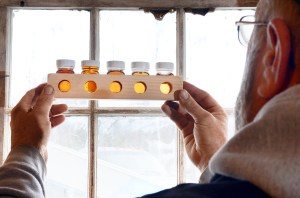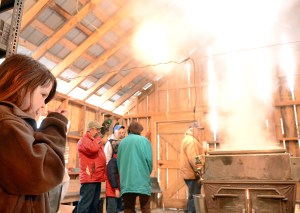Editor’s note: This story was updated to correct Kurt Becker’s name.
POLAND — At Russell Hill Farm, owner Kurt Becker was busy tending the evaporator and answering questions in his 20-foot-square sugar shack on the 30th Maine Maple Sunday.
In front of his house family members served up pancakes and maple-related wares, including maple candy and baked goods. It’s his fourth year of sugar production but his first with a shack to work from.
Becker described his evaporator as a two-by-six, a designation syrup producers use referencing the size of the actual evaporation surface area.
The $6,000 unit is perfect for Becker’s 375 tapped maples on his property. Becker said there are approximately 1,000 trees that could potentially be tapped if he could keep up with the sap flow.
Becker showed off his system to a small group that had gathered. First a vacuum draws sap from the trees via plastic taps with check valves, through tubes of various gauges, to a larger collection tank a few yards from his shack. The check valves in the taps prevent the possibility of sap flowing back into the trees in the event of pressure failure.
Plastic tubing has made sap collection much easier than in the days of dragging a sled from one tree bucket to the next. However, Becker still needs to walk his lines regularly to make sure the vacuum isn’t disrupted. Wind, weather and wayward animals pose a constant risk to the lines.
The sap can only stay in the collector for about two days before going on to the evaporator, “After three days, it starts to cloud up,” Becker said, making it cloudy.
Becker’s evaporator is wood fired. When asked how much wood he usually burns a season, he laughed and said, “A lot.” According to Becker, an efficient wood-burning system produces about 25 quarts per cord of wood. With an expected outcome of 50 to 70 gallons, he can expect to burn through eight to 11 cords of maple and ash this spring.
That was a production goal Becker had last year before the entire industry in Maine was hampered by an early thaw and erratic springtime temperatures. Becker said he was only able to produce 20 gallons throughout the entire season.
Becker looked forward to this year, and so far the weather has been encouraging. “I think I’ve lost 12 pounds now with maple season,” he said, darting around the front of his evaporator to check the fire.
“It’s all in the temperature,” Becker said. According to Becker, syrup is produced at seven degrees above boiling. One degree less, Becker said, and you have sap. One degree more, and you have candy.
“I’m learning as I go.” Becker said other syrup producers have helped a great deal. “The maple community is really a good bunch of people,” he added, noting that rivalries and trade secrets are almost unheard of in Maine.
Although Becker said he feels the syrup runs through his veins, he admits profit margins are slim. He and his wife, Hope, also grow blueberries and vegetables to keep the farm working.
A short trip from the cozy Becker farm to Megquire Road proved to be like night and day. Before Harvest Hills Farm was even visible, cars lined the road as families made their way to a waiting horse-drawn cart or hayride down the long dirt road, past the alpacas and goats, to the sugarhouse.
To call Harvest Hills’ sugar production facility a sugar shack would be a gross understatement. With an oil-fired four-by-sixteen evaporator, it requires a small barn to house production.
According to owner Peter Bolduc, the current system is the fifth upgrade since starting sugar production. The first sugar shack now serves as a foyer for the current evaporator. It’s what Bolduc calls the “sugaring disease,” or the strange, obsessive, progression from backyard boiling to professional production.
The farm where sugar production takes place is the old Megquire Farm, built in 1791 and one of three farms owned by Harvest Hills.
Bolduc said that so far production is down with cold day and night temperatures slowing sap to a trickle over the past two weeks.
“You have to be an optimist,” Bolduc said of farming in general. He said that over the last 100 years late March through early April have provided optimal temperatures for sugar production.
Approaching the sugarhouse, a long tent served as a corridor and wind break for guests lining up for pancakes and bacon. Along the sides of the tent, various maple products were displayed for sale. Maple candy, maple bread and, of course, syrup were for sale along with other farm products like Harvest Hills honey.
Inside the evaporator room, breakfast was being served in a warm cloud of sweet vapor. Outside, picnic tables were sheltered where people were serenaded by the bluegrass stylings of the local group The Grassholes, who, by the way, were nice enough to interrupt a set to return a wayward reporter’s dropped notebook.
Bolduc sees Maine Maple Sunday as a catalyst. “Everybody’s been cooped up all winter,” he said, and the annual event is a great way for people to get out of the house and taste this tangible evidence of spring.
Although appearing as a big fish in the sugaring pond, Bolduc feels a closeness with others in the trade, “There’s a sense of community among sugarmakers,” Bolduc said. “Everybody I’ve met in the 15-plus years of doing this has been helpful.”
Bolduc also spoke highly of the Maine Department of Agriculture for promoting Maine Maple Sunday and credits its staff with its continuing success and growth.




Comments are no longer available on this story